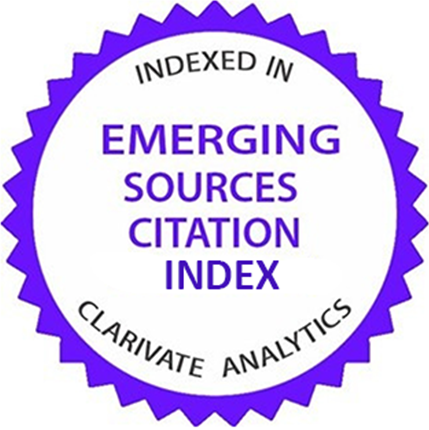The diagnostic value of T-wave to R–wave amplitude ratio on electrocardiogram in the diagnosis of hyperkalemia
Abstract
Objective: The aim of this study is determining the diagnostic value of the T-wave to R–wave amplitude ratio (T/R ratio) in the electrocardiogram (ECG) at the time of admission in terms of the diagnosis of hyperkalemia in patients who are at risk for hyperkalemia who apply to the emergency department (ED).
Methods: This cross-sectional study was conducted with patients over 18 years of age who presented to the ED and have an estimated glomerular filtration rate (eGFR) below 60ml/min/1.73m2. The patients were divided into 2 groups according to the potassium value; hyperkalemia and normokalaemia groups. T/R ratios were measured on the ECG. All measurements were made in these precordial leads; V2, V3, and VT highest (is defined as precordial lead where the T wave is measured the highest).
Results: A total of 345 patients with low eGFR were included. Hyperkalemia was detected in 115 (33.3%) of these patients, while 230 patients (66.6%) were in the normokalaemia group. T wave amplitude and T/R ratio were found to be statistically significantly increased in the hyperkalemia group in all leads (V2, V3, and VT highest). Area under the curve (AUC) values are 0.778 for T/R ratio and 0.717 for T wave amplitude.
Conclusion: The presence of increased T/R ratio in the ECG of patients with known low eGFR may be more helpful for the diagnosis of hyperkalemia than the classical hyperkalemia ECG findings.
2. Wong CK, Jaafar MJ. Bradycardia, renal failure, atrioventricular nodal blockade, shock, and hyperkalemia: an important syndrome to recognize. Turk J Emerg Med. 2021;21(2):86-9.
3. Peacock WF, Rafique Z, Clark CL, Singer AJ, Turner S, Miller J, et al. Real world evidence for treatment of hyperkalemia in the emergency department (REVEAL-ED): a multicenter, prospective, observational study. J Emerg Med. 2018; 55(6):741-50.
4. Einhorn LM, Zhan M, Hsu VD, Walker LD, Moen MF, Seliger SL, et al. The frequency of hyperkalemia and its significance in chronic kidney disease. Arch Intern Med. 2009;169(12):1156-62.
5. Celebi Yamanoglu NG, Yamanoglu A. The effect of calcium gluconate in the treatment of hyperkalemia. Turk J Emerg Med. 2022;22(2):75-82.
6. Montague BT, Ouellette JR, Buller GK. Retrospective review of the frequency of ECG changes in hyperkalaemia. Clin J Am Soc Nephrol 2008;3:324-30.
7. Clase CM, Carrero J-J, Ellison DH, et al. Potassium homeostasis and management of dyskalemia in kidney diseases: conclusions from a kidney disease: improving global outcomes (KDIGO) controversies conference. Kidney Int. 2020;97(1):42-61.
8. Wrenn KD, Slovis CM, Slovis BS. The ability of physicians to predict hyperkalemia from the ECG. Ann Emerg Med. 1991;20(11):1229-132.
9. Regolisti G, Maggiore U, Greco P, Maccari C, Parenti E, Di Mario F, et al. Electrocardiographic T wave alterations and prediction of hyperkalemia in patients with acute kidney injury. Intern Emerg Med. 2020;15(3):463-72.
10. Aslam S, Friedman EA, Ifudu O. Electrocardiography is unreliable in detecting potentially lethal hyperkalaemia in haemodialysis patients. Nephrol Dial Transplant. 2002;17(9):1639-42.
11. Green D, Green HD, New DI, Kalra PA. The clinical significance of hyperkalaemia-associated repolarization abnormalities in end-stage renal disease. Nephrol Dial Transplant. 2013;28(1): 99-105.
12. Montague BT, Ouellette JR, Buller GK. Retrospective review of the frequency of ECG changes in hyperkalemia. Clin J Am Soc Nephrol. 2008;3(2): 324-30.
13. Emektar E. Acute hyperkalemia in adults. Turk J Emerg Med. 2023;23(2):75-81.
14. Buerschaper L, Floege J, Muehlfeld A, Schlieper G. Evaluation of electrocardiographic parameters predicting cardiovascular events in patients with end-stage renal disease before and after transplantation. Kidney Blood Press Res. 2019;44(4):615-27.
15. Kovesdy CP, Matsushita K, Sang Y, Brunskill NJ, Carrero JJ, Chodick G, et al. Serum potassium and adverse outcomes across the range of kidney function: a CKD prognosis consortium meta-analysis. Eur Heart J. 2018;39(17):1535-42.
16. Rautaharju PM, Surawicz B, Gettes LS. AHA/ACCF/HRS recommendations for the standardizationand interpretation of the electrocardiogram: part IV: the ST segment, T and U waves, and the QT interval a scientific statement from the American Heart Association electrocardiography and arrhythmias committee, council on clinical cardiology; the American College of Cardiology Foundation; and the heart rhythm society endorsed by the international society for computerized electrocardiology. J Am Coll Cardiol. 2009;53(11):982-91.
17. Moranne O, Froissart M, Rossert, J, Gauci C, Boffa J, Haymann, et al. Timing of onset of CKD-related metabolic complications. J Am Soc Nephrol. 2009;20(1):164-71.
18. Çorbacıoğlu ŞK, Aksel G. Receiver operating characteristic curve analysis in diagnostic accuracy studies: a guide to interpreting the area under the curve value. Turk J Emerg Med. 2023;23(4):195-8.
19. Alfonzo A, Harrison A, Baines R, Chu A, Mann S, MacRury M. Clinical practice guidelines: treatment of acute hyperkalaemia in adults. UK Renal Association. 2020:26-8.
| Files | ||
| Issue | Vol 8 No 2 (2024): Spring (April) | |
| Section | Original article | |
| DOI | 10.18502/fem.v8i2.15463 | |
| Keywords | ||
| ECG Emergency Department Hyperkalemia T/R Ratio | ||
| Rights and permissions | |

|
This work is licensed under a Creative Commons Attribution-NonCommercial 4.0 International License. |










